Etiology
It is caused by avian influenza virus H5N1
Virus resistance
The virus could easily be killed by antiseptics and bleaching agents.
Zoology - Transmission
Avian, aquatic birds, ostrich, particularly avian are very sensitive to the disease. Human and others mammals could also be infected. Because birds are also sensitive to this illness, consequently beside the transmission through avian and their products transportation, wild birds could be considered as a contributing risk to the distribution of disease.
Clinical signs:
Sudden death before showing clinical signs
Lower the activity, eating and drinking habit of the herd.
Decrease in birth rate, change in egg shell properties.
Eyes swollen and discharge.
After 3 days of incubation, some animal will be twisted neck, legs and wings paralysis, unusual position of the head and the body.
Infected and death rate could be high, up to 100% in a herd.
Control:
In epidemic area
Every poultry, aquatic avian including chicken, duck, turkey, goose, etc. must be eliminated.
Materials, cages, transportation, working clothes must be disinfected carefully.
Do not slaughtered or consumed infected products.
People who work against the disease must be fully equipped.
In non-infected area:
Restrict contact or importation of poultry, aquatic birds and others related products from the epidemic area. Birds should also be restricted around the farm.
Perform a careful annually disinfection of the cage: choose 1 of the 3 disinfectants BIOXIDE, BIODINE ® or BIOSEPT.
Increase the resistance ability of the herd: BIO-VITAMIN C 10%, BIO VITA-ELECTROLYTES.
Prevent the infection from others respiratory infected bacteria with antibiotics: BIO-TYLOSULFADOXIN-C, BIO-NORXACIN, BIO-E.T.S and BIO-OXYTETRACOL.
Each doses should be provided 2-3 days every week until the end of the disease outbreak.
 |

 Hotline:
Hotline:

.jpg?width=120&height=90&mode=pad&anchor=auto&scale=both)









Comments